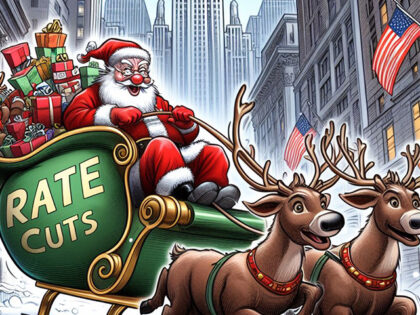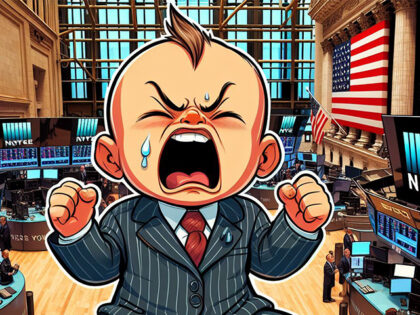Jobless Claims Plunge To 201,000, Creating Further Doubts About Rate Cuts
There’s no sign of cooling in the labor market, putting rate cuts into doubt.

There’s no sign of cooling in the labor market, putting rate cuts into doubt.

The decision of the Fed to start cutting interest rates bears a strong resemblance to the decision to marry. It can be reversed but only with a great deal of awkwardness, some economic difficulty, and often a reputational cost.

The evidence is mounting, as solid and as undeniable as the ground beneath our feet. Inflation is here, it’s real, and it’s time to pay attention.

Inflation, having long since overstayed its welcome, announced on Tuesday that it was just getting comfortable.

The Federal Reserve justifiably received a lot of criticism for its tardy response to the surge of inflation. Now its critics accuse it of being too hesitant to lower interest rates.

Monetary policy may be a dead end. Perhaps it’s time to start looking elsewhere for what is really driving inflation and growth.

The economy appears to be able to operate at a high rate of growth with interest rates that would have been seen as highly restrictive in the pre-pandemic era.

So, what does it sound like when doves cry?

Fed officials continue to push back against the market’s forecast for an aggressive cutting cycle this year.

The most underpriced risk in financial markets right now is a rate hike from the Federal Reserve.

The possibility of an interest rate hike is “the most underpriced risk in the market right now,” Breitbart Economics Editor John Carney told Fox Business host Larry Kudlow.

The Bond Market Is Like a Dog Walking on Two Legs We have it on the authority of James Boswell that in the summer of 1763 Samuel Johnson said that “a woman’s preaching is like a dog’s walking on his

Federal Reserve Chair Jerome Powell admitted that he was wrong to expect inflation would be transitory when it started to rise three years ago. Powell said that “in the fourth quarter of ’21, it became clear that inflation was not

The surprisingly strong January jobs report reflects real employment and productivity growth and not just growth in government or government-adjacent hiring, Breitbart Economics Editor John Carney told Fox Business host Larry Kudlow.

The Fed Fights Back The Federal Reserve delivered a shock on Wednesday by announcing that it does not anticipate cutting rates until it gets more confident that inflation is moving toward two percent. “The Committee does not expect it will

“The Committee does not expect it will be appropriate to reduce the target range until it has gained greater confidence that inflation is moving sustainably toward 2 percent,” the Fed said

The Shaky Edifice of Improved Consumer Confidence Americans are feeling better about the economy than they have in years. Or at least Democrats are. Consumer confidence—as measured by the Conference Board’s monthly survey—surged to a two-year high in January, the

Will the Fed defend the position it staked out in December or capitulate to the view of bond traders?

The Federal Reserve has a lot less influence over business activity than is commonly thought.

The economy is signaling that it does not need a rate cut to keep growing. The question is whether the Federal Reserve is listening.

This week’s economic data very likely pushed the timing of a rate cut further out on the calendar.

Despite all of the data and the statements from Fed officials, the market has clung to the conviction that a rate cut is coming as early as March.

Nothing in the latest economic data provides a justification for the Federal Reserve to cut interest rates after its March meeting, Breitbart Economics Editor John Carney told Fox Business host Larry Kudlow.

The American consumer’s strength may be the force that wrestles the market out of the conviction that the Fed will cut interest rates this March.

The prospects of a soft landing for the economy is no reason for the Federal Reserve to rush into rate cuts.

The losses could contribute to higher budget deficits for years to come.

An election year rate cut followed by a rise in inflation and then a new hiking cycle would cement the view that the Federal Reserve acted on political motives.

The basic premise behind the conviction that the Federal Reserve will start cutting rates in the first quarter of next year is looking shakier.

It’s fun to play with Frosty the Snowman, but eventually he melts.

The market’s reaction to the Fed’s dovish pivot last week is withstanding the pushback from former and current Fed officials.

“Problem is, the central bank’s dovishness also increases the possibility of no landing at all,” Bill Dudley warned.

New York Federal Reserve President John Williams said Friday that rate cuts are not a topic of discussion for the central bank.

The markets are delighted that they heard Powell say, as he drove out of sight, “Rates cuts for all—and to all a good night.”

We doubted Fed Chairman Jerome Powell was going to play the Grinch at his press conference today, but we did not expect him to play interest rate Santa Claus.

The Federal Reserve left interest rates at 5.25 to 5.5 percent.

Buckle up and return to your seats. There’s likely to be some turbulence ahead.

The Federal Reserve may have to get back to work.

Jerome Powell probably did not mean to trigger a significant easing of financial conditions on Friday, but that’s exactly what he did.

The market immediately priced in much larger odds of a cut in March and May.

The most striking thing about President Biden announcing a special White House council on supply chains is that it took until this Monday to happen.
